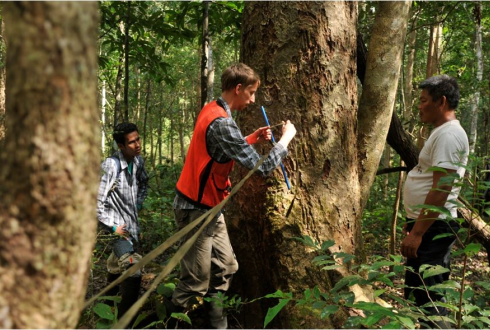Tropical forests not as untouched as often thought

Tropical forests may not be the ancient, unspoilt ecosystems we have always assumed them to be. This notion needs to be revised, write Wageningen University researchers in the January issue of the scientific journal Forest Ecology and Management. In a protected forest area in Thailand, clues have been uncovered that suggest that large swathes of forest have been felled on numerous occasions within the last 150 years. This was not done by humans, but by hurricanes.
The researchers conducted their research in the Huai Kha Khaeng Wildlife Sanctuary situated in the west of Thailand. This area is a UNESCO world heritage site, rich in endangered plants and animal species, and is home to a large population of tigers. "The unspoilt nature of the site makes it an ideal area to study the natural development of a tropical forest," reports Mart Vlam of the Forest Ecology and Forest Management Group at Wageningen University.
Mystery
"This research was begun to investigate why a tree species native to the area did not regenerate well. There were many large trees of this species, but very few small ones. We wanted to know why this was happening to the Afzelia xylocarpa," says Mart Vlam. The team researched this with the help of tree rings. "For a long time it was thought that tropical trees did not make tree rings. There are, after all, no clear seasons in the tropics. This region in Thailand has a clear dry season which is actually a sort of winter when almost no rain falls. Many trees lose their leaves, and form tree rings that enabled us to determine their age."
It was found that the Afzelia trees displayed a remarkable age distribution. There were trees that were approximately 160 years old and ones that were around 60 years old, but no younger trees. This meant that there had been a few peak years in which lots of trees had grown up simultaneously. "These peak years are a strong indication of large-scale disturbances in the forest, when many large trees died and in turn allowed new trees to become established," explains Mart Vlam. The researchers suggest three reasons for this. Firstly, trees of the same age were often found in close proximity, an indication that the circumstances in certain areas had changed all at once. Secondly, both younger and older trees displayed a growth spurt when they were small, which could only have happened when there was an abundance of light and they were therefore not overshadowed by existing larger trees. Thirdly, the forest around the 160 year old trees was much taller than that surrounding the 60 year old trees. This meant that the forest in which the older trees grew was itself older too.
Hurricanes passing through
"We suspect," says Mart Vlam, "that the forest was hit twice by a passing hurricane that felled many trees. It is possible that this was followed by severe forest fires, caused by the large amount of dead wood left after the storm. Measuring tree rings allows us to understand the natural rejuvenation process of this type of tree much better. We have also discovered, however, that this seemingly untouched forest has actually undergone severe disruptions in the recent past."
More information: Vlam, M., Baker, P.J. Bunyacejchewin, S., Mohren, G.M.J. & Zuidema, P.A. (2014). "Understanding recruitment failure in tropical tree species: Insights from a tree-ring study." Forest Ecology and Management, 312, 108-116. dx.doi.org/10.1016/j.foreco.2013.10.016
Journal information: Forest Ecology and Management
Provided by Wageningen University

















